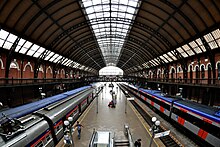Companhia Paulista de Trens Metropolitanos
The Companhia Paulista de Trens Metropolitanos (CPTM) is a system of suburban railways established in 1992 in the metropolitan region of São Paulo . It is subordinate to the Secretaria de Estado dos Transportes Metropolitanos and is operated like an S-Bahn . Two more lines are currently being planned. The CPTM thus complements the existing subway network and the various bus networks.
history
The history of the railway in the state of São Paulo goes back to the year 1867, when the first rail connection, the route Santos - São Paulo - Jundiaí, was established by the São Paulo Railway (SPR) in what was then the province of São Paulo of the Brazilian Empire . This route crossed the São Paulo plateau and then descends through the coastal mountains to the port of Santos .
In 1957 the railway companies and lines were merged into the state railway company Rede Ferroviária Federal (RFFSA).
The Ferrovia São Paulo e Rio de Janeiro was completed in 1870, a railroad that connected São Paulo with the cities in the Paraíba river valley and is now part of the CPTM's Linha 11 - Coral . Around 1890 this route was allocated to the Estrada de Ferro Central do Brasil (EFCB) company and in 1926 the EFCB constructed a variant that was henceforth called Poá and is now the Linha 12 - Safira of the CPTM. On the other south side there was the Estrada de Ferro Sorocabana, which was built in 1875 and connected São Paulo with Sorocaba and today in the CPTM partially corresponds to the Linha 8 - Diamante .
In 1937 the Estrada de Ferro Sorocabana also built connections connecting the cities of Mairinque and Santos , with the aim of creating an alternative between the highlands and the coast, which until then had been a monopoly of the SPR. Later the connection via Jurubatuba to Santos was built, which started from the Imperatriz Leopoldina station and led to the Evangelista de Souza station on the Mairinque – Santos line. Today this route corresponds to the Linha 9 - Esmeralda of the CPTM.
All rail lines in the state of São Paulo were nationalized in 1971 and merged into Ferrovia Paulista SA (FEPASA). For its part, FEPASA founded the subsidiary FEPASA DRM, which was responsible for the administration of the suburban passenger routes. In the 1970s, the company Empresa Brasileira de Transporte Urbano (EBTU) was responsible for this area and in 1984 it merged with Companhia Brasileira de Trens Urbanos (CBTU), which was then renamed CPTM in 1992.
FEPASA's freight lines were privatized from 1996 by the Ferroviária Federal (RFFSA) speech , by auctioning off the individual line sections for the concession and later also dissolving the RFFSA.
Today the CPTM is used regularly by around 1.9 million passengers. The poor condition of the rail network prompted the state government to carry out a modernization that cost approximately 1½ billion US dollars between 1995 and 2004. In order to standardize the means of transport in the state, the CPTM was subordinated to the Metrô de São Paulo in 2008 .
Lines
The numbering of the lines starts with seven, as the numbers one to six are assigned to the Metrô São Paulo .
| Lines | Terminals | Length (km) | Number of stations |
|---|---|---|---|
| 7th | Luz ↔ Jundiaí | 60.5 | 17th |
| 8th | Júlio Prestes ↔ Amador Bueno | 41.7 | 24 |
| 9 | Osasco ↔ Grajaú | 31.8 | 18th |
| 10 | Luz ↔ Rio Grande da Serra | 37.2 | 14th |
| 11 | Luz ↔ Estudantes | 50.8 | 16 |
| 12 | Brás ↔ Calmon Viana | 38.8 | 13 |
| 13 | Engenheiro Goulart ↔ Aeroporto-Guarulhos | 12.2 | 3 |
Web links
Individual evidence



